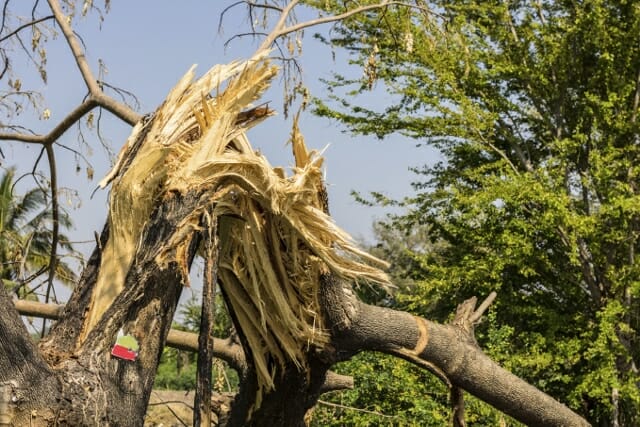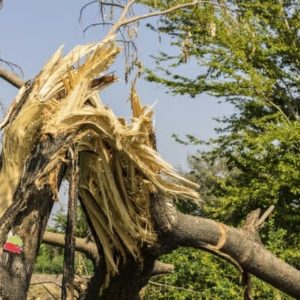
Recognizing and Handling Tree Hazards
Dr. Leonard Perry, Extension Professor
University of Vermont
 Trees are essential to life, providing significant aesthetic, environmental, and ecological benefits. Yet trees can fall or shed branches, potentially injuring property or even people. If you have trees in a landscape, or simply walk or work in public spaces with trees, it’s important to be on the lookout for potential hazards. Some of the following tips can be found in a leaflet from the International Society of Arboriculture (ISA)—the professional organization for those dealing with trees and the science of trees, or “arboriculture”.
Trees are essential to life, providing significant aesthetic, environmental, and ecological benefits. Yet trees can fall or shed branches, potentially injuring property or even people. If you have trees in a landscape, or simply walk or work in public spaces with trees, it’s important to be on the lookout for potential hazards. Some of the following tips can be found in a leaflet from the International Society of Arboriculture (ISA)—the professional organization for those dealing with trees and the science of trees, or “arboriculture”.
Places to look for potential tree hazards are over walks and near roads, near buildings, and near power lines. The latter, in particular, can cause problems and danger, as we all know, when limbs fall on and take down power lines. If you spot any limbs on power lines (not so much an issue on phone or communication lines), call your local town public works or utility. Even if a tree near a building doesn’t pose current hazards, some prefer to remove them, or at least adjacent limbs, to avoid potential building damage during high wind and storms.
What you should look for are defects in trees. While one defect may not pose a hazard, several often will. One of the common defects is simply dead or dying branches, diseased ones, or old ones with few leaves. Look for wounds, particularly old ones with rot or decaying wood, or ones over half way around the tree. The extreme of wounds is an open cavity in a trunk or branch with insufficient sound wood (less than an inch for every 6-inch stem or trunk diameter).
A less extreme tree wound, but indicating the tree is failing, is one with cracks or deep splits in the bark. Look for cracks in large branches, deep cracks through them, or two or more cracks in the same area.
Mushrooms at the base of trees indicates rot and unhealthy growth, a tree potentially that may fall under wind, storm, or ice stress. The same applies to trees that are leaning significantly.
Forked trunks forming a sharp “V” angle are much less stable, and prone to breaking apart, than branches at a more horizontal or right angle. Such branches usually have bark, not solid wood, in this sharp junction. This is common in some species of maples and ash trees.
If many branches arise from the same part of the trunk, these will be prone to breaking off. This is commonly seen when trees have been sheared or “topped”, particularly repeatedly. This happens, particularly in urban areas, where large trees were misplaced under power lines.
Also look for trees misplaced, as in the wrong soil type. Most trees prefer a well-drained soil, and if in heavy or wet soil will be stressed and grow poorly. Those planted in sites after new construction may not have the proper soil and conditions, or be too near buildings as they grow larger. Stressed deciduous trees (those that lose their leaves in fall) or parts of trees, from whatever reason, often turn color much earlier in the fall.
Existing trees in construction sites may be injured, if not the tops then the roots. Such root damage can be as simple as from paving over roots, repairing sidewalks, or digging trenches for utilities. Such trees will decline over the coming years, sides of the tree may die, and potentially they will pose future hazards. Human activities such as parking or driving vehicles under trees, can compact the soil and weaken roots too.
Simply raising the soil level around trees can weaken them, either through trunk damage or burying the many roots near the surface too deeply. This can happen from installing lawns, making raised beds near or around trees, or mulching too deeply around trunks (known as “volcano mulching” from its appearance). Another aspect of lawn care to consider is that using weed killing herbicides, even those commonly combined into fertilizers, near or under trees can kill them too.
If trees were in a dense grove or wooded area, and this was thinned out, remaining trees may be spindly and not very strong. Such trees are more prone to falling or dropping limbs.
If you spot tree hazards in public spaces, contact the local town or city arborist. If on your own property, only deal with tree hazards you can safely handle. Use proper and sharp pruning tools, and if using a chain saw make sure you know how to operate it properly and safely.
Spring is the best time for routine pruning, but any time is appropriate for removing hazardous trees and limbs. This applies especially to dead wood—limbs or whole trees. These are dry and brittle, do not bend, and can break or fall at any time. Especially watch for “hangers”– those already broken and hanging precariously. Look for those already broken and lodged in a tree, subject to falling at any time.
Large limbs or ones high off the ground, full size large trees, limbs that need cabling together or bracing, or limbs near power lines should be left to professionals. You can find certified arborists online from the ISA consumer website, along with more information on keeping trees healthy (www.treesaregood.org).
Good culture and routine maintenance will keep trees healthy. Healthy trees pose few hazards and can weather climate extremes better than those receiving little to no care, or ones stressed from a poor environment. Proper pruning from an early age of the tree will lead to a strong tree later.
11/1/14
Distribution of this release is made possible by University of Vermont Extension and New England Grows–a conference providing education for industry professionals and support for Extension’s outreach efforts in horticulture.
Receive your complimentary Relocation guide and magazine


